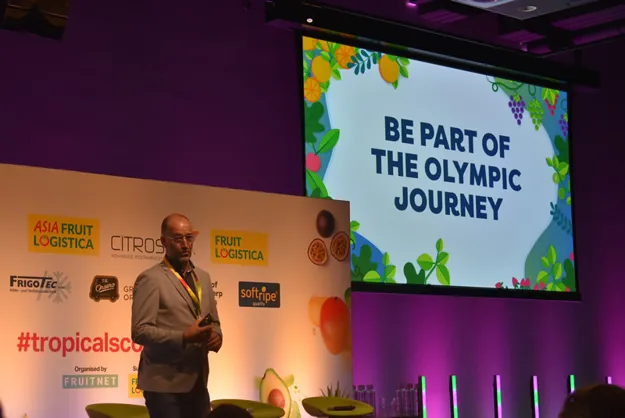Climate change, inflation, and the social sentiment regarding importing exotics - the global export sector faces many challenges. Not all were solved last week during the Global Tropicals Congress in The Hague, but solutions were provided. Some 200 participants from 23 countries attended this new Fruitnet event.
Rabobank's Cindy van Rijswick kicked things off. She started with the good news: sea freight costs have normalized. However, fruit volumes have also returned to pre-pandemic levels. European retail sector fruit purchases have not yet returned to pre-2020 levels, with the Netherlands as a positive outlier. Foodservice sales, too, have recovered.

Cindy van Rijswick (Rabobank) and Charles-Henri Deprez (Greenyard).
The avocado market, with its extreme growth over the last decade, can safely be considered the exotic sector's success story. Now, says Cindy, the market is entering a new phase with more producing regions like Morocco, Colombia, and Africa emerging. North America and Europe are by far avocados' main sales destinations. People have high expectations of Asia, though there, avocado sales have stagnated in the past five years.
The mango market is growing strongly, too, but annual consumption varies greatly. Also, sourcing consistent quality and quantity is a major challenge in this market. According to the Rabobank analyst, the pineapple market showed price recovery signs in 2022, but those were also much needed. In Europe, the pineapple market has not grown for years, so it will have to reinvent itself.
That says Cindy - referring to her packing a dragon fruit and spoon as part of her son's lunch - is where the outcome lies. "Commoditization is one of the biggest threats to this sector. It's better off focusing on tropical fruits' appearance, quality, flavor, and sustainability than on price and volume, despite the current tough times. It's hard to escape once your product's considered a commodity. But with exotics, you can steal the show."
This summer, Olympic Fruit did extensive market research. Sales and Marketing Manager Desmond Jas explained the results in his presentation. It showed that consumers eat fruit primarily because it is healthy and satisfies their hunger before the next meal. That snacking moment - which accounts for only 11% of fruit consumption - lends itself best to increasing exotics consumption, says Jas. No exotic fruit is among the top five fruits consumed as snacks (apples, bananas, grapes, mandarins, and strawberries).

Desmond Jas (Olympic Fruit)
Inflation impacted exotics sales. Maria Wieloch of Swedish retailer ICA says sales of tropical fruits that were relatively inexpensive, such as limes and passion fruit, remained level. According to the category manager, you can't keep doing the same thing when there's price pressure. This retailer, for example, chose to position passion fruit on the dairy shelf. Campaigns via platforms like TikTok are also becoming more decisive for fruit purchases.
Attention was also paid to packaging facility working conditions. The chain has a growing understanding that improving those conditions is a shared responsibility. Simon Derrick of Blue Skies - one of the largest employers in Ghana - gave an overview of how good working conditions can increase profits.

Stephan Schneider with his former colleagues Leon Blaak and Edwin Fillekes of HillFresh.
Xavier Roussel of Dole and Johnathan Sutton of Westfalia's presentations touched on the sustainability challenges. According to Xavier, when facing these challenges, engaging with other platforms and NGOs outside the industry is essential. "Nothing's impossible, but not everything can be solved today," he says.
Johnathan pointed to Westfalia using spray applications as an example. That has reduced the water needed to grow a kilo of avocados to 250-550, depending on the growing area. There is also much to be gained from switching to regenerative agriculture, adds Lieselot van der Veken of Pro Terra Agro. "Microbiology is the key to life."
Technology can prove beneficial, too. Tineke van de Voorde of the Port of Antwerp and Bruges - by 2022, accounting for 520,000 tons of conventional goods and 950 reefer containers of perishables - talked about the new apps technology this Belgian port is using. That gives its clients real-time information via, among other things, a terminal tool.

Lieve Michielsen and Joep Jongmans of Special Fruit
Frigotec's Roland Wirth explained how the revolutionary Softripe system elevates exotics' ripening. The system uses Artificial intelligence (AI) under a Controlled Atmosphere. A shorter ripening time (three days for avocados) leads to less loss and fewer complaints.
According to Roland, the Sofripe system is now widely appreciated in Europe, and they now want to make the move to other continents. Weight loss is what Citrosol wants to combat with its coating. Benito Orihuel indicated that this coating could save up to 955 kilos of avocados per container. It looks promising with limes, too.
Mango quality management - which still come from numerous small producers - is challenging. AI-powered software can help control quality risks and manage uncertainties, Joep Jongmans of Special Fruit and Daria Reisch of Agrinorm told attendees.
"The key to success lies in companies' ability to cooperate and exchange information. Growers must know which variety is performing best so they can plant more of it next year. And distributors need to see if it's rained in the orchards, so they can estimate shelf life and choose the correct market," they explain.
New producers and suppliers got the chance to present their products alongside the larger exotics producers. For example, Kaushal Khakhar of Kay Bee Exports gave a presentation on India's great potential as a fruit producer and exporter. The company ships some 8,000 tons of fruit and vegetables by air freight. Pomegranate (seeds) and mangoes are the biggest products, but the company also brings Sapodilla, guava, and coconuts to the global market. It has 800 acres of its own cultivation and 1,200 acres of contract cultivation.
The Canary Islands are also producing more exotics. Its banana sector, for example, provides 12,000 jobs, Clara Chico of Asprocan claims. Canarian bananas have a protected designation of origin and, for some time, have had a good presence in the Spanish market. But they are now also marketed by retailers in France, Switzerland, Belgium, and Morocco.

Spanish papayas, too, are becoming increasingly popular. An advantage, according to Jorge Igancio Brotons of Bonnysa, because the product's footprint is five times lower than overseas papayas. Currently, Europe absorbs 30% of all papayas grown worldwide, with 4.7% from its own production. With an average annual per-household consumption of 560g in Spain and 130g in the EU, consumption is still low. Still, papayas grow by around three percent per year in the European Union and are now the fourth-largest tropical fruit, consumption-wise.
FMI's Peter Bouman gave the audience a peak into the lime market - more on this later. Charles-Henri Deprez of Greenyard concluded by giving his view on the exotics market. He says avocadoes owe their success to standardization. Buyers know what to expect throughout the year.
That is not yet the case with mangoes. A solution could be to focus much more on events where mangoes are heavily promoted when they have good quality and availability. According to Charlles-Henri, that would lead to more repeat purchases and fewer disappointed shoppers.
